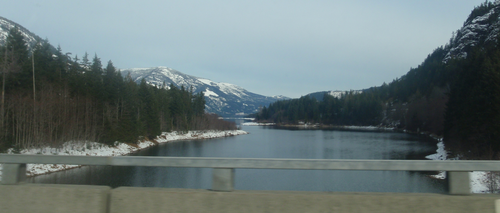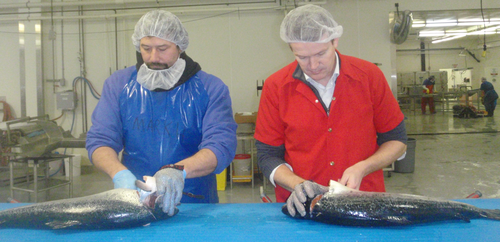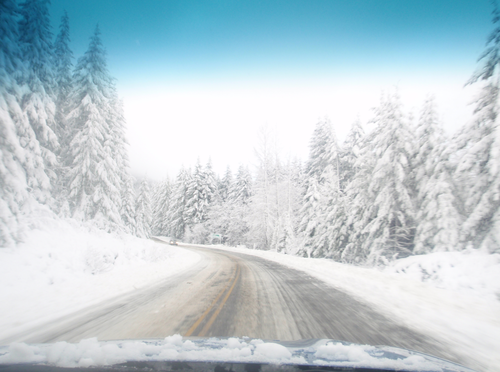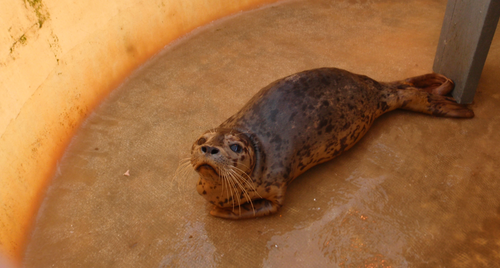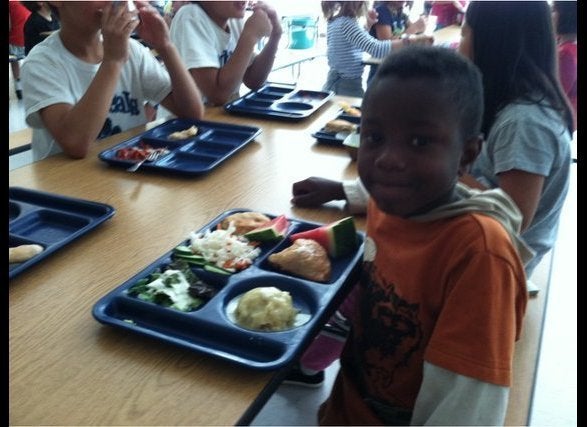
Food Informants is a week-in-the-life series profiling fascinating people in the food world. We hope it will give you a first-hand look at the many different corners of the food industry. Know someone who would make a great Food Informant? Tell us why.
Skuna Bay is a Vancouver Island-based craft salmon farm in which the salmon are raised in the ocean. Skuna Bay has been certified under BAP (Best Aquaculture Practices), and has been accepted into the Aquarium of the Pacific's Seafood for the Future program. Los Angeles restaurants such as Bouchon, Son Of A Gun and Nobu all use Skuna Bay salmon.
Stewart Hawthorn is the the principal farmer for all of Skuna Bay’s salmon farming activities. He began farming salmon on the west coast of Scotland almost 25 years ago, first on the Isle of Skye, and later at Loch Sunart and Loch Diabeg. After gaining experience in Europe, North America called and life found Stewart working at Limekiln Bay on the eastern coast of Canada. New Zealand was his next stop, raising salmon in the Marlborough Sounds and savoring the region’s wines. In the early 1990s, Stewart took a sabbatical from salmon farming and spent several years in rural Papua New Guinea, where he worked to implement sustainable freshwater carp pond farming at the village level. Now at Skuna Bay, Stewart believes that by farming salmon, he helps to reduce the influence of invasive practices of large scale fishing companies and the pressure on wild salmon populations. When Stewart isn’t busy crafting salmon, or caring for his extensive family, he can still be found along the water swimming in lakes and rivers. He also plays squash, and enjoys hiking and running. He is a member of the BC Salmon Farmers Association, and sits as a Board Member at Vancouver Island University.
Read Stewart's diary below to learn about how a craft salmon farm is run, and how Skuna Bay cares for its fish.
Monday, February 27
5:55am: Wake-up alarm -- time to get up, light the wood stove and to get the coffee on.
6:25am: Kerry, my better half, drives me to the Denman Island ferry. The ferry leaves at 6:40am sharp (or sometimes even a little bit ahead of schedule, so you can't be late). It is a beautiful morning -- clear sky, spectacular sunrise. A perfect start to the week.
6:55am: Ferry arrives at Buckley Bay. Then there is the 35 minute drive to Campbell River. This is where our main office is and where we coordinate the farming and other activities of Skuna Bay craft-raised salmon. On the way there are several bald eagles that are cruising the sky -- getting ready to start their day.
8:04am: Conference call with the farmers at the Gold River hatchery. Barry (fish vet and the guy who looks after the farming processes), Robin (our quality and freshwater guru) and I are heading out there after the call. We check into how the fish are doing and to make sure that the guys on the ground have everything they need to rear great fish (you'll hear that a lot around here!).
9:35am: What a great day for driving. We travel through the Strathcona Provincial Park. The mountains are majestic and they surround glassy calm lakes.
10:05am: Arrive at the hatchery. The setting is awesome. Steep mountain cliffs guard the hatchery that is nestled near the mouth of the Gold River as it enters Nootka Sound. Gold River is a small town that was founded on the forests of BC -- with a pulp and paper mill and logging being the mainstay for the community for many years. Now it is forestry, fish farming, tourism and the great outdoors that supports many here.
10:27am: Another conference call. I'm on the phone with the Seafood for the Future Program Manager, Kim Thompson. We discuss Kim's recent visit to our operations. Seafood for the Future is the Aquarium of the Pacific's sustainable seafood choices programme that endorses responsible seafood capture and farming practices. Skuna Bay is proud to be part of the programme -- but it is demanding as we need to be open and transparent about everything that we do.
10:50am: At last I get to go and look at some fish. I head out to the place where all of our little baby salmon are and meet up with Sarah. Sarah keeps a close eye on everything that happens from egg right through until the little fish take their first bite of food. The goal of the Gold River hatchery farmers is to exactly mimic the pristine river environment that salmon eggs would naturally be laid in (hopefully minus the bears, but they do come around from time to time...). Each group of eggs is given a unique source of clean and pure water. The eggs spend about 90 days developing in their little groups. Then they hatch. That is what was happening today with some of the fish. I check with the team and see what a great job they are doing. Keeping the groups of eggs clean, removing any eggs that did not make it. Some of the baby Coho salmon are now taking their very first bites of food. This is carefully dropped in to them -- they are enthusiastic feeders. It is great to see them doing so well.
11:30am: I move on to another part of the Gold River farm. In this part of the farm we have lots of baby salmon that are being prepared to go out to the ocean net enclosures (at this stage we call them "smolt"). Salmon are hatched and initially raised in freshwater, but they grow in the sea. We need to carefully check that the fish are ready to go to the ocean net enclosures -- because salt water is very different from freshwater. These baby fish are now just over 1 year old. They are getting fed a diet that is rich in protein and energy. They are looking really good -- nice and big, plump and fit. In a couple of weeks they will be ready for the journey to their natural ocean environment.
1:25pm: Barry, Robin and I catch-up with Mike Anderson. Right now he looks after everything that goes on at Gold River. It's a big responsibility -- as all of our Skuna Bay fish start their life right here at the Gold River hatchery at the head of Nootka Sound. He's sounding upbeat -- the fish are doing well. The eggs are hatching. The little fry are starting to eat. It feels like we have a great new generation of Skuna Bay salmon growing just perfectly. But they have a long way to go -- it will take another 3 years for those first feeding fry to be harvested and sent to our customers around North America.
1:43pm: We leave the hatchery for the drive back to Campbell River We debrief and talk about the weeks and months ahead for the Freshwater craft farmers -- there is a lot to do but I am feeling really positive that they are on top of things.
3:04pm: Back in Campbell River. I've got a meeting with Cam -- a second generation fish processor and the person who looks after all of the preparation of our Skuna Bay fish from harvest until they are packed and ready to go to market. We're talking about eggs again. This time eggs that are destined for being turned into salmon roe. Cam has developed a Japanese ready salmon roe product called "ikura." Cam gently takes the salmon eggs from mature fish and then marinades them in a secret recipe sauce -- these are then sold to retailers in Japan. We grow some Coho salmon especially for the eggs and Cam is keen to take more of these for the Japanese market.
3:45pm: I touch base with some of the team in the office. Walter, our Controller needs me to make some time to talk with the auditor of our accounts, Marilyn who looks after our sustainability and First Nations relationships talks to me about discussions with two of the Nations whose territories we farm in.
4:00pm: I get a text from Kerry with the shopping list -- one of the joys of living on an Island is that I get to do most of the shopping. It's time to hit the road so that I can get to the store then get back in time to catch the 5pm ferry from Buckley Bay to Denman Island. Island life is great -- but you quickly learn that the ferry waits for no-one and clock watching becomes a bit of an obsession.
5:30pm: Kerry and I have time for a quick walk with the two dogs (Star and Maddie) and our daughter, Morag. Morag takes a carrot for Jahan the horse that is in the paddock at the end of road.
7:25pm: Dinner -- lamb stew. Delicious!
Tuesday, February 28th 2012
7:35am: Ferry arrives in Buckley Bay - there was only one other foot passenger today and not too many cars. I guess the weather is putting people off.
8:23am: Line up for the Quadra Island Ferry. This ferry leaves Campbell River ever hour or so and travels to Quadra Island. It's a slightly longer run than the Denman Ferry and much more exposed. There is a bit of a roll in the Straight. Quadra Island is just off of Campbell River. It is a beautiful place and is the home of the Wei Wai Kai First Nation.
8:50am: Arrive Quadra Island. There is a short 15 minute drive ahead as I am going to the family owned and operated Walcan fish processing plant. Walcan, run by Cam Pirie who I met up with yesterday, has been processing fish for almost 40 years. They are real experts and believe in custom processing by hand. We really like what they do with our Skuna Bay salmon I'm going to check out the processing today, have a look at some of the fish to make sure that the really tough standards that have been set are being adhered to and also try my hand at filleting -- we need to understand how our Skuna's work for the Chefs. The only way to do that is to do it yourself (or at least to watch the experts do it!).
9:07am: The fish are looking great! This is the first "pull" from a new farm location, Atrevida, that is located in Nootka Sound. The fish have nice thick belly walls, beautiful body conformity, nice tight scales, bright eyes and red gills. That is everything that we need them to be to qualify as Skuna's. I head straight for the gutting line -- it is a bit like medieval medicine, but you can really tell a lot from what a fish's viscera looks like! And to me (this is what gets me going after all) these guts are looking good -- with nice amounts of fatty tissue and consistent colour telling me that the fish were in great condition when they were harvested.
10:05am: I head over to the Skuna Bay line. Only a small proportion of the total harvest makes it to Skuna Standard. And there are only 6 people in the entire Walcan team who have been approved to select, prepare and pack Skuna fish. It is so important to get this piece of the puzzle right. It has taken our craft farmers 3 years to get these fish to this point. Today there is Luc, Colin and Lisa selecting the Skuna Bay salmon. Each fish is carefully inspected, given a very thorough clean then put through several special "ocean fresh" steps that help to lock in that "fresh from the ocean quality." Finally 3 fish are gently placed into the recyclable Skuna carton, individually iced, then the box is firmly closed with a tamper proof seal. The finishing touch is when one of the Skuna selectors individually signs and dates a label that is proudly put onto the carton. The next person to touch these fish will be the Chef in their kitchen. That is something that we can guarantee.
10:54am: Ray picks out a few fish then we head over to a quiet part of the plant to do some hand a filleting. It is amazing to watch the ease with which he can run a knife through the salmon and within seconds there are a couple of perfect fillets. Me, well it's not terrible, but I'd need a lot more training to make it into Ray's filleting team! The Skuna's are great though and very forgiving. Nice firm fillets with tight musculature.
11:33am: Walcan processes our craft-raised salmon, wild run salmon, shellfish, shrimp, black cod, herring and all sorts of other seafood delights. We are very fortunate to have this great partner to work with -- it means that we can concentrate on farming and we can trust that the processing will be done to a high standard every time.
12:11pm: I head back to the Quadra Ferry line-up and arrive in Campbell River. I head over to the BC Salmon Farmers Association. We discuss how we are going as a farming community. This is important stuff as we are dedicated to reducing pressure on wild stocks and helping to feed the world.
5:50pm: Check into the Coast Discovery hotel in Campbell River. The weather is getting worse and I don't want to drive back to Denman Island in driving snow.
6:08pm: Dinner at the Dolphin Resort -- this place has some of the best food in Campbell River.
9:15pm: I head back to the hotel. I'm glad I decided to stay local -- there is snow on the road and more piling up on top of it. It's time for a beer.
Wednesday, February 29
6:54am: Head outside to go and meet Blair at the office. Whoa! There is about 3 inches of thick and icy snow and my car is covered in it.
7:04am: Arrive at the office. Blair, who looks after our farms on the west coast of Vancouver Island, is waiting for me. This is where we farm most of our fish -- in Nootka Sound and Esperanza Inlet. He must have seen the snow and given himself extra time to get to our meeting point. I grab a "survival suit" for when we are out on the water -- this suit keeps you warm and provides floatation if you are unfortunate enough to fall into the water. It is not the easiest to walk in, but you're not cold.
7:25am: Beautiful drive today -- the snow is clinging to the branches of the trees. We are surrounded by nature's ice sculptures. We are heading out on the same road to Gold River, through Strathcona Provincial Park. The farms we are heading for are situated in Nootka Sound -- where Captain James Cook landed, in 1778 on the West Coast of Canada for the first time.
9:23am: We arrive at the Muchalaht South farm and are greeted by Leon and Shaun. They are feeding baby salmon (smolt) that have recently been transferred from the Gold River hatchery to this farm location. They are pleased to report that the little fish are thriving -- eating well, growing well and loving their natural ocean environment. We spend time talking about what the key tasks that are coming up, discussing the farm environment -- water temperatures, water oxygen levels, plankton and salinity.
10:25am: Blair and I head off towards the Concepcion farm. This farm is a 20-minute fast boat ride away. There are three farms in this next area and our farmers work here with one age group of salmon. So the fish at Concepcion, Atrevida and Williamson are all one year older than the Muchalaht South fish and will all grow through to harvest then the whole area is left fallow prior to restocking. This is one of our craft farming techniques that helps to make sure we treat the environment that we are working in respectfully. At Concepcion we meet up with Jeff. He is one of our expert farmers and is really in tune with how his livestock is doing. Jeff loves his fish and is passionate about making sure that they get fed fantastically well.
11:15am: We are getting ready to leave Concepcion when Blair notices that a Californian sea lion has managed to get past our external predator net. The fish are still secure in their net enclosure, but we don't want the sea lion this close to them. Blair hangs back at the farm to get the sea lion out. I head over to the Atrevida farm to catch-up with Kyle and the gang over there.
11:20am: I arrive at Atrevida. This is where we were harvesting our Skuna Bay fish from yesterday. Kyle shows me around the farm -- he's feeling on top of things and pleased to be harvesting. He's been responsible for these particular fish for coming up for two years. It is always nice to see them heading off the farm and on their way to market -- mission complete!
12:22am: Blair calls on the farm radio. He's checking in as he's been alone for about one hour. It's important that we keep tabs on each other in this environment as things can quickly change. Our rule is that every hour we check in when working alone. The good news is that Blair managed to get the sea lion out of the farm. He lowered the predator net down from the surface and created a tunnel. The sea lion was a bit wary to start with, but eventually got the idea and made a dash for it. As soon as he was out Blair quickly lifted the net up again and secured it.
12:48pm: Blair arrives at Atrevida. We wait for the incoming crew to turn up.
12:54pm: Cory and Ray arrive -- they are looking fit and refreshed and are ready for their eight days looking after their livestock in this fantastic place. We briefly talk about the plans for the next few weeks and months then Blair and I head over to the Williamson farm.
1:23pm: At Williamson, Steve and his team are settling in. Again we discuss where things are at, tour around the farm checking on our animals and discuss the things that need to be done.
5:12pm: I get back in the car and head for the Denman Island ferry. The road trip is clear and easy. The bad news is that I forgot to grab the Skuna Bay salmon fillet from the office fridge - so there will be slim pickings for dinner tonight!
6:35pm: Back home. The dogs are happy to be out of the car, running down the drive and looking for Morag.
Thursday, March 1
6:55am: Heading for Nanaimo today -- catching a float plane to Vancouver.
7:48am: Arrive Nanaimo and check-in at Harbour Air for the direct flight to Downtown Vancouver. This is a really convenient and smooth service. The people at Harbour Air have really got it right -- you can easily change flights, get allocated to later flights if you miss your connection and cancel at the last minute if you need to -- all for no penalty. It is not at all like commercial flights with traditional carriers.
8:10am: Boarding the float plane to Vancouver. The views are really great from these small planes -- they fly low and land right in the harbour in downtown Vancouver.
9:06am: I'm at the Vancouver Aquarium's Marine Mammal Rescue Centre I'm meeting with Lindsaye and Tarin. They run the Aquarium's rescue centre that is located on land right in the middle of Vancouver. Everything that this centre does is funded by donations -- they don't get any government support for the rescue centre. There are many dedicated volunteers (apparently retired nurse's have great skills!) who help to look after the animals. Right now it is the off season. So there are only 2 harbour seals and, unusually, one harbour porpoise. Most of the time the Centre looks after seal pups that have been either abandoned or lost. (Sometimes a mother will leave the pup on a log boom which is then towed away -- when the mother comes back the logs are gone, along with the baby pup. The tug skippers then notice the baby pup and give the Rescues Centre a call.) In the busy season there can be over 100 animals on site at any one time.
I'm meeting Lindsaye to talk about our seal and sea lion management programme. Seals and sea lions are clever animals who know a good feed when they see one and sometimes our farms can attract them. Land farmers have to protect their stock from wolves or domestic dogs and we need to manage seals and sea lions to minimise and hopefully eliminate any negative interactions. Occasionally a seal or sea lion will get into our net enclosures and they can cause a lot of damage in a very short period of time. We are looking to find better ways to get these animals out of our farms -- and we hope that we can get some good ideas from the Rescue centre. We also hope to get them to assist us in exceptional circumstances. The idea that we talk about today is that the Aquarium's veterinarian might be able to temporarily knock an animal out with a dart gun so that our farmers can get the animal out of the net enclosure so it can be released unharmed. This might be needed once every year or two. That would reduce the risk of the animal getting entangled in a net or of us needing to resort to more permanent options! Lindsaye is pleased that Skuna Bay is looking to keep improving and wants to discuss with others at the centre and at Vancouver Aquarium.
10:48am: Time to move on to a meeting with Albion Fisheries. They are a dedicated seafood specialist distributer in Western Canada. They source seafood (wild and farmed) from a range of suppliers and then distribute this quickly and efficiently to their customers. They are committed to sourcing responsibly and I am talking to them about carrying our salmon and working out the logistics associated with this. Freddy Cirillo pick's me up and we head over to their facility.
12:05pm: After meeting with Freddy, John, Chris and Ted I get a tour of their receiving, processing and shipping areas. It is fascinating to tour a facility like this. There is a vast array of different species of seafood. Many of these I have never heard of, never mind tasted! Albion is pretty unique in that they source a lot of different types of products then process it into formats that their different customers require. They have everything from live crabs to individually packaged salmon portions.
1:06pm: I meet up with Blair and Charna of Calkins and Burke. This is another seafood broker. They handle a lot of our salmon that does not make the Skuna grade. We've had a long and mutually beneficial relationship with C&B. We are discussing the future in terms of our customers needs and how we get fresh salmon from BC to the rest of North America.
4:10pm: I check in with Harbour Air for the flight back to Vancouver Island. My original flight is booked for 5.30pm - but they shift me to the 4.20pm flight. That is perfect as it means I should be able to catch the 6pm ferry back to Denman Island (rather than the 8.30pm that I was probably going to catch).
Friday, March 2
7:37am: Arrive Coast Discovery Hotel, Campbell River. I'm have a breakfast meeting with Frode, who is a freshwater farming guru. He worked in Canada in the past, but now lives and works in Norway. Frode has been at our Gold River hatchery for the last few days helping to further enhance the skills and knowledge of our freshwater farming team. He reports great progress and is impressed by our teams willingness to soak up new ideas and ability to implement them.
8:16am: Leave the hotel and head to the office. I've got a conference call scheduled for 9am with Cascades who have developed the unique recyclable cardboard carton that we use with our Skuna Bay salmon.
9:02am: Martin, from Cascades in Quebec joins the call. His team has developed a unique cardboard carton called "Thermafresh'" that we ship our Skuna Bay salmon in. It is a big improvement on the existing styrofoam boxes that everyone else uses because it can be completely recycled in existing cardboard recycling programmes. Styrofoam is a big problem for the seafood world -- with this packaging being great for getting product to customers in good condition, but it is not so good to dispose of once it has been used. We are talking with Martin about his packaging and how we can extend this format over more of our salmon.
9:44am: I get on the road again to the Gold River hatchery.
11:10am: Arrive at the hatchery and go back into the egg holding area. More eggs have hatched since earlier in the week. The exciting news is that this part of the system is now much less busy that it was on Monday. A whole batch of our baby "first feeders" (fry) have been moved over to the first feeding ponds. The team is really proud of the good work that they have done -- bringing eggs through this sensitive time to hatch is no mean feat.
12:02pm: I'm now back in Gold River town at the Manila Gourmet restaurant. I have a meeting with some of our First Nation partners in whose territory we farm. It is important that we have good relations with the Nations whose territories we work in. I discuss with the Chiefs some of the challenges and opportunities that Skuna Bay is working on. Overall I am pleased with our relationships with First Nations -- there is still work to do but we are getting there. All of the Nations we work with take their guardianship of the environment and their territory very seriously and that fits well with our commitment to farming responsibly.
1:51pm: I catch-up with Mike and then head to the ponds with the salmon fry in them. They are looking good in their new home! The ponds need to simulate the sleepy headwaters of a river system where the eggs would naturally hatch. Our farmers don't only tend the fish, they also tend the water. This is the most important factor in raising Skuna Bay salmon. Without very high quality water you can't grow good fish. They spend a lot of time checking that the water has everything that these sensitive soon-to-be-first-feeders need. These fish will be held in the ponds for a few days without any need for feed -- they are still living off the yolk that the egg was laid with. But as soon as this is exhausted it is important that lots of food is available. In the wild, the fish get this from the streams that they are born in (but most of the little fish won't make it as there simply is not enough food around). But in our farming environment we can make sure that there is lots of feed for the little fry and so most of them do very well.
2:46pm: Leave Gold River -- heading back to the office to pick-up a side of Skuna Bay craft raised to take home for dinner tonight.
6:25pm: Time to get dinner on. Friday night is my night. And tonight is Skuna Bay salmon night. We have a mix of salmon sashimi (finely sliced chunks of buttery, melt in your mouth salmon) and broiled salmon (mirin, soy sauce, ginger and onion marinade), Japanese rice and salad. Delicious!
See more Food Informants below:
